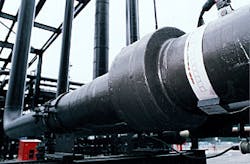Chris Caunter
Rabco Industrial Inspection Ltd.
Poole, U.K.
A flexible transducer system has been fitted to a pipe Fig 1.
With ultrasonic techniques and a novel method of transducer arrangement, a newly developed remote corrosion-monitoring system can monitor oil and gas pipelines in remote and hostile environments as well as process plants in hazardous locations.
The system can be fixed permanently at a site where corrosion is to be expected and produce reliable and repeatable results of inspections on request. It has been applied at BP Exploration's Wytch Farm gathering station in Dorset, U.K.; at the Shell Chemie refinery, Purnis, The Netherlands; and at a flow line network operated by BP Exploration in Colombia.
Manual execution
Condition monitoring is a vital function in the management of any process plant. It is important for maintaining plant integrity, meeting production requirements and satisfying health and safety considerations, and complying with environmental legislation.Plant inspection and monitoring regimes are today just as important to the productive and safe operation of process plants as are production control systems and the process plant itself. This is especially the case with the oil and gas industry.
Corrosion monitoring is an increasingly important component of condition monitoring. In the oil and gas industry, process pipework and vessels are subject to constant corrosion and erosion by the very nature of the product which they carry or contain.
Corrosion monitoring is still, however, often carried out manually, which can lead to misinterpretation of results and can cause problems when corrosion readings are taken at slightly different points over time.
In addition, corrosion measurements must often be made in hostile environments or at locations of difficult access. Taking the measurements, then, could involve shutting down a plant or, at the very least, erecting scaffolding or removing insulation.
If corrosion monitoring is to be practical and the results meaningful, there is obviously a need for a technique which can be applied remotely, can guarantee accurate, repeatable, and reliable results, and can generate high-quality data, that need no specialist interpretation.
Development
Essentially, corrosion monitoring relies on measuring the wall thickness and identifying change in this wall thickness of pipes or vessels. This is usually done ultrasonically, employing the so-called pulse-echo technique.A single transducer is coupled to the surface of the pipe or vessel to be monitored by means of a thin layer of couplant and excited by a high-voltage transient to emit a very short pulse of sound (Fig. 1).
This pulse travels through the wall of the pipe or vessel and is reflected off the back surface or earlier if there is a defect in the wall. The returning pulse is detected by the same transducer, amplified by suitable electronics, and displayed on a CRT display or equivalent. Application of a simple algorithm makes it then possible to determine the exact wall thickness.
Historically, ultrasonic techniques have been applied manually, involving scanning a transducer over the area to be monitored. Apart from the subjectivity of such operations, these inspections can be time-consuming and disruptive to plant operation and involve significant labor costs.
To remove the human element from the inspection procedure, a system has been developed which can be fixed permanently where corrosion is expected and produce on request reliable and repeatable results of inspections.
The ultrasonic component of this system, from Rightrax Ltd., Warrington, U.K., is a novel, flexible array of piezoelectric transducers. The array is produced from very thin strips of piezoelectric film. Both surfaces are covered with a thin metallic electrode, and one of these surfaces has the continuous electrode arranged into a series of conductive pads and tracks.
Each of the pads constitutes a transducer element. A series of 14 elements is connected by the conductive tracks to a small enclosure, fitted to the end of the strip. This enclosure contains a temperature sensor, a small calibration block, and an electronics module, which has built-in memory to store local site identification.
The flexible array is easily attached to structures by means of an integral double-sided adhesive tape, which also provides the acoustic bond. Its extreme flexibility means that it can be bonded to complex-geometry plants and small- radius bends without crumpling, and it can operate continuously at temperatures in excess of 110° C.
Signal output from the electronics module is by a weatherproof coaxial cable which can be connected to one of two processing modules, depending on the level of operator expertise.
For skilled ultrasonic operators, the Rightrax S1 module is an intelligent multiplexer interface, which allows the connection of conventional single-channel, flaw-detection equipment to the flexible transducer array via the coaxial cable.
It is essentially an intelligent switch and contains all the circuitry necessary to handle transmission of digital data, dc power, ultrasonic, and HV pulsar signals along the coaxial cable.
However, the Rightrax DL1 data logger eliminates the need for a skilled NDT operator because it contains built-in intelligence to collect, process, and store measured wall thickness.
It drives the transducer array, activates each individual sensor in turn, optimizes and processes signals, displays all associated parameters, and stores all information for subsequent downloading via an integral RS232 interface. It is portable and battery-powered and contained in a compact IP-rated housing.
An important aspect of the DL1 data logger is the way that it can be configured with a variety of appropriate signal-transmission equipment.
Monitoring in practice
In its simplest form, a remote corrosion-monitoring system is used in situations that require virtually continuous monitoring or for monitoring at frequent, prescribed periods.Typically, this can be in a process plant, or topsides of an oil platform, where it is essential that information be constantly available on the integrity of a pipeline or vessel which is known to be subject to corrosion influences.
In this instance, an array or multiple arrays of transducers are applied to the surface to be monitored and data are obtained either manually, by downloading the data logger, or remotely, often via the RS232 connection and a hard-wire link to some central control point.
The data can then be further transmitted for off-line processing to a second location.
Inaccessible plant site
A more common application of remote corrosion-monitoring technology is that in which the plant to be monitored offers very difficult access. This can be because it is covered with insulation or because it is located in a remote part of a process plant, often at great height.It can also be because the plant to be inspected is a buried pipeline. These conditions make manual monitoring difficult, costly, and sometimes impossible.
This was the situation at BP Exploration's Wytch Farm gathering station in Dorset, U.K., commissioned in August 1994.
At this site, on the south coast of England, BP Exploration gathers around 100,000 b/d of oil from local offshore installations.
Engineers had suspected that there was a possibility of weld corrosion in the underground flow lines from offshore installations to the onshore gathering and processing plant.
Consequently, the pipeline was unearthed and a weld survey carried out. Whenever corrosion was identified, that particular weld was ground flat and a flexible sensor fitted across the dressed weld region.
Each sensor was then hard-wired to the surface as the pipeline was reburied and terminated at a suitable IP68 socket, protected by a concrete post, the concrete posts being approximately 30 m apart. Readings are taken by plugging in a DL1 data logger; it takes one operator 15 min to monitor all 98 locations (Fig. 2).
Often corrosion monitoring must be carried out in a plant located in hazardous areas. Manual inspection of such a plant necessitates shut-down, at great expense and disruption of production.
This was the case at the Shell Chemie plant, Purnis, The Netherlands. Located in the Europort, the chemical plant is the largest in Europe, manufacturing acids and plastics.
A routine inspection of a 15 year-old cooling tower in a hazardous zone revealed that extensive corrosion had taken place on the top third section. Consequently, it was decided to shut down the tower operation and to overlay the areas subject to corrosion with weld.
When the remedial action had been carried out, it was agreed that the repaired area should be monitored regularly. To begin with, this was carried out by manual ultrasonic inspection, which also involved stripping insulation from the cooling tower and erecting substantial scaffolding, at a cost approaching £500/week.
To reduce these costs and achieve greater control over the inspection operation, Shell decided to investigate the possibilities of remote corrosion monitoring. Five Rightrax sensors were permanently fitted beneath the insulation on the 1.2-m diameter cooling tower so that the complete system could provide wall-thickness data at 70 separate locations (Fig. 3 [134,353 bytes]).
The sensors are controlled by Rightrax DL1 data logger, which is located inside a site-approved enclosure and is hard-wired to the control room, some 50 m away. Wall-thickness readings are saved to disc for subsequent analysis, and a hard-copy report is produced every 8 hr.
The total inspection operation is automatic, as well as being remote, and there is no need for inspection personnel to be present within the hazardous zone at any time. There is now no need for decommissioning and stripping insulation every time inspection is carried out. As a result, the system paid for itself within 3 weeks, and accuracy and reliability of results have been improved.
Although, in this instance, communication between the monitoring system and the control room was by hard-wired link, it is possible to achieve effective communication with radio modems, and the system can be solar powered.
Monitoring in hostile environments
Process plant, and especially pipe work, is often located in extremely hostile environments, subject to extremes of climate. This is the case with the flow line network operated by BP Exploration Colombia. But hostility is also evident in the form of sporadic terrorist activity, making integrity monitoring of the buried pipeline with traditional techniques extremely difficult.Because of the high temperatures in the flow lines (around 110° C.), intelligent pigging is not an option because pigs could damage the semiprotective corrosion product film, accelerating corrosion problems.
The central processing facilities of BP Exploration Colombia produce 164,000 b/d of oil day and can compress up to 1.4 bcfd of gas. The corrosion-monitoring systems are fitted on two pipelines which feed the central processing facilities and on one export line.
BP in Aberdeen carried out trials of the Rightrax corrosion-monitoring system to meet BP Exploration's specific corrosion-monitoring needs.
Three critical areas were identified on each flow line, areas where water drop-out is predicted. At each location, 10 Rightrax flexible-transducer arrays have been fitted, each configured to provide 14 individual sensors, a total of 140 corrosion-measuring points at each critical area (Fig. 4 [97,573 bytes]).
The sensors are connected through a daisy-chained, high-temperature coaxial cable, and the sensor-and-cable assembly is then fully encapsulated in the pipeline coating material. The coaxial cable is plugged into a DTS 2000 data-transmission modem, which is integrated with an internal battery and a DL1 data logger.
The complete corrosion-monitoring and data-transmission system is then reburied with the pipeline, protected against water ingress and mechanical damage.
Communication between the data-transmission modem and the remote central processing facility is via the metal structure of the pipeline itself because the DTS 2000 uses extremely low frequency signals with peak-to-peak voltages which sum to zero over time.
The system's power supply is provided by the internal battery, which is recharged between transmissions by drawing a small current from the pipeline's local cathodic-protection (CP) potential.
In operation, a start-up signal is sent to the DTS 2000 from the central processing facility and then "wakes up" the data logger, which interrogates every transducer on every M1 array, in turn.
Data are collected relating to local thickness, temperature, and CP potential, and each data package contains the transducer identification and the inspection time.
The data logger collects and processes the information, which is then transmitted by the DTS 2000 back to the central processing facility. Here a PC with a network interface can provide remote access to the information anywhere in the world.
The new system is now allowing BP Exploration Colombia to manage inevitable corrosion problems cost-effectively. It is also allowing continuous monitoring of corrosion inhibitor efficiency, which again leads to cost saving as the use of expensive corrosion inhibitor can now be optimized.
Developments
Transducer arrays are now being investigated for subsea application, and development is continuing on variations in data-transmission methods and system configurations.For example, a pipeline corrosion-monitoring system is available which can be used in hostile desert conditions. The data logger and a radio modem are buried in the sand in an enclosure suitable to help maintain a stable temperature. The transducer array or arrays are hard-wired to the data logger, which is powered by a local solar-panel mast.
Data are transmitted to a remote station modem/PC system by the radio modem.
At the other end of the climatic scale, a system is also being developed for pipelines in extreme cold. Again, radio modems can be used for data transmission, but in this case the data loggers are powered by a thermo-electric generator, which is clamped to the pipe.
The Author
Chris Caunter is managing director of Rabco Industrial Inspection Ltd., Poole, Dorset, U.K. He gained his qualifications and initial experience in non-destructive testing (NDT) in 5 years' experience with Inspection Engineering Services and British Industrial X-Ray Ltd. In 1975, Caunter joined F.H. Gottfeld, Herne, Germany, where he became involved with the inspection of fossil fuel- and nuclear-powered power plant, concentrating on specialist ultra-sonic techniques. He was appointed non-destructive testing manager at Rabco Industrial Inspection Ltd. in 1980. He attended Bournemouth College of Further Education in 1970.
Copyright 1999 Oil & Gas Journal. All Rights Reserved.




